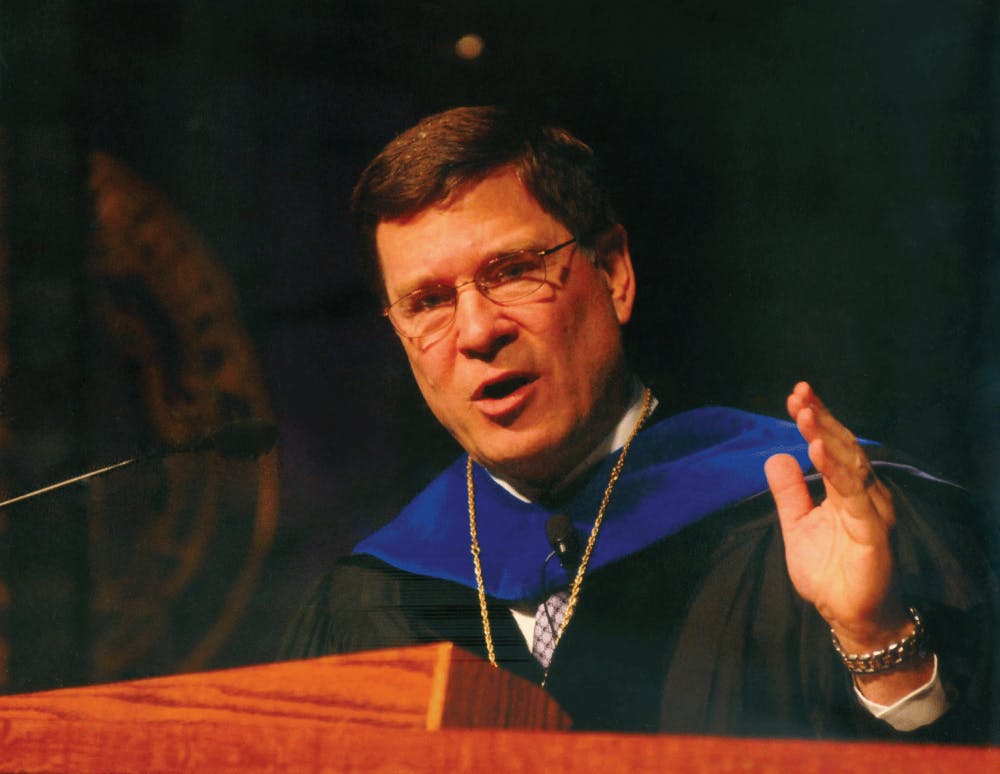By David Adams | Echo
Editor's Note: This is the first in a two-part series introducing Strategic Directions 2026 to the Taylor community. We'll begin by looking back at Vision 2016. In two weeks, we'll take a look at the process that will shape the new 10-year plan.
Vision 2016, a 10-year plan for Taylor's growth and advancement, was originally announced in April 2006 at the inauguration of Taylor President Eugene Habecker.As the university embarks on a two-year journey to develop Strategic Directions 2026, the successor to Vision 2016, it's worth understanding what Vision 2016 was meant to be, what has changed about Taylor in the last decade, what hasn't-and why.
Habecker summarized what Vision 2016 means for the university: "Vision 2016 has given us some clarifying objectives that have helped guide decisions and choices and priorities for the university over the past eight-plus years."
Masters of Arts and Higher Education (MAHE) student Jeff Aupperle was tasked by the Strategic Directions 2026 Steering Group, a 15-member committee appointed by the president, with reviewing Vision 2016 and evaluating Taylor's progress. He presented his research, "Vision 2016 in Review," in a Sept. 30 campus forum to faculty, staff and students.
Aupperle canvassed presidential board reports from early in Habecker's tenure and identified four main tenets for Vision 2016.
New mission statement
The first goal was a new mission statement, one that would clarify the university's goal "to reclaim a role on the global stage," Aupperle's report said.Taylor's current mission statement was adopted for the 2009-2010 academic year after significant effort on the part of Habecker and the board of trustees, an early accomplishment of Vision 2016.
10-10-10 plans
Vision 2016 included the deployment of three presidential strategies-creating 10 master's programs, 10 endowed centers of excellence and 10 Taylor "centres" around the world-to meet the goal established by the new mission statement.Four masters programs were running at one point in the last eight years, two more than were running prior to Vision 2016. Since that point, the Master of Arts in Religious Studies program was discontinued, and the Master of Environmental Studies is currently not recruiting additional students. Habecker said Taylor is reconsidering what the role of graduate education should be, but that having more students in fewer programs rather than more programs could be a viable goal.
Aupperle's report said six of the 10 planned centers of excellence are up and running. The Center for Teaching and Learning Excellence is established and nearing full endowment. The Center for Scripture Engagement is partially endowed and still developing. Centers focusing on missions computing, ethics, C.S. Lewis and faith, film and media remain in "exploratory" phases.
Of the possible global centres Vision 2016 conceived, only programs in Ireland and Ecuador are fully established. Habecker said a study to explore the next steps in starting global centers is underway and will be completed in the next two years.
Increased enrollment
The third goal Aupperle documented was increasing undergraduate enrollment at Taylor to 2,400 students by 2016, about 500 more than there are currently."I think we were probably a little bit aggressive," Habecker said of the enrollment target, noting the economic recession of 2008 and 2009 as one reason for the smaller-than-anticipated growth.
Physical improvements to campus
The final goal of Vision 2016 was a collection of new buildings and renovations, according to the Campus Master Plan. Euler, Breuninger, Campbell, Wolgemuth, upgrades to the football stadium and other athletic facilities and substantial landscaping and building renovations were all completed as part of the plan.When the new Campus Center opens, as early as 2016, it could stand out as the final accomplishment of Vision 2016 before Strategic Directions 2026 comes into play.
What's next?
In considering the ways Taylor fell short of the Vision 2016 goals, it's helpful to remember the plan, as Aupperle pointed out, was "shared with the campus community as a possible vision to be pursued, not necessarily as a set of firm outcomes to be accomplished."
Unforeseen circumstances like the recession, the closing of the Taylor Fort Wayne campus and the van accident of 2006, among other challenges, forced Taylor to revise its plans along the way.
"Will we complete everything? Probably not-that's a fair assumption," Habecker said of Vision 2016's goals. "But I think all of us have a sense of gratitude to what the Lord has provided thus far and, God-willing, will continue to provide as we move into the future."





